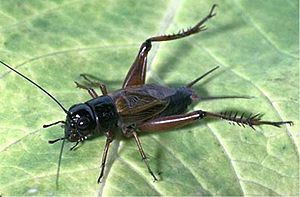Southeastern field cricket facts for kids
Quick facts for kids Southeastern field cricket |
|
|---|---|
 |
|
| Gryllus rubens in Alabama | |
| Scientific classification | |
| Genus: |
Gryllus
|
| Species: |
rubens
|
The Gryllus rubens, also known as the southeastern field cricket, is a type of field cricket. You can find it across most of the Southern United States. Its home range goes from southern Delaware to the far southeastern part of Kansas. To the south, it lives from Florida all the way to eastern Texas.
Contents
About the Southeastern Field Cricket
What Does It Look Like?
It can be tricky to tell the Gryllus rubens apart from another cricket called G. texensis. They look very similar! However, female G. rubens crickets have a longer ovipositor. This is a special tube they use to lay their eggs. Scientists think G. rubens might have come from a group of G. texensis that became separated over time.
How Their Wings Change
One cool thing about G. rubens is that their wings can change. This is called polymorphism, meaning they can have different forms. In spring and summer, many G. rubens crickets have long wings that reach the end of their body. But in autumn and winter, they often have short wings.
This change used to be thought of as mainly due to the environment. However, later studies found something interesting. For female crickets, their genes play a bigger role in deciding wing length. For male crickets, the environment still seems to be more important. So, it's a mix of both genes and the environment that affects their wings.
Why do wings change? Short-winged female crickets lay eggs earlier and lay more of them. Long wings need more energy and nutrients to grow and stay healthy. This means long-winged females might have smaller ovaries and lay fewer eggs. For male crickets, having short or long wings doesn't seem to change when they are ready to mate or how many offspring they can have.
How They Digest Food
Gryllus rubens crickets have three main helpers for digestion: protease, amylase, and lipase. These are special chemicals called enzymes. They work in the cricket's midgut and hindgut. People used to think only the midgut did most of the work breaking down food. But now we know the hindgut is just as important for turning food into nutrients.
Their Courtship Songs
One of the main ways to tell G. rubens apart from G. texensis is by their courtship songs. These are the sounds male crickets make to attract females. G. rubens songs have more low-frequency "ticks" in each part of their song. They also have more "pulses" in their trills.
Scientists studied how female G. rubens react to these songs at different times of the year. In autumn, fewer females would go near a singing male. They also spent less time close to him. This shows that the season can affect how females respond to songs.
Another study looked at how male G. rubens react when they hear other males singing. Young crickets will move towards the song. They might be trying to find and attract any females nearby. Older crickets, however, will often sing back with their own song.
G. rubens can also live in the same areas as another cricket called G. firmus. It can be hard to tell these two apart too! But their songs are different. G. rubens has a slower song than G. firmus. Also, the side parts of G. rubens' front wings are pale with veins that are hard to see. G. firmus has veins that are lighter than the rest of the wing.
Who Are Their Predators?
The tachinid fly called Ormia ochracea is a predator of G. rubens and other crickets. This fly uses the crickets' courtship songs to find them. The flies are attracted to the sounds the crickets make.
Once a female O. ochracea fly finds a cricket, she lays her tiny young (larvae) on it. These larvae quickly burrow into the cricket's body. They grow inside the cricket for about 7 days. After this time, the larvae come out, and sadly, the cricket dies.

